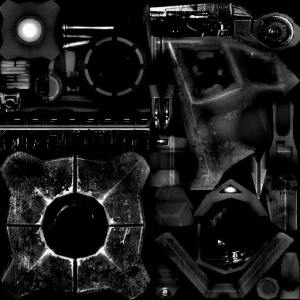$envmapmask: Difference between revisions
Jump to navigation
Jump to search
 Warning:
Warning:

TomEdwards (talk | contribs) mNo edit summary |
TomEdwards (talk | contribs) mNo edit summary |
||
| Line 59: | Line 59: | ||
* [[$phong]] (diffuse reflection) | * [[$phong]] (diffuse reflection) | ||
[[Category:List of Shader Parameters| | [[Category:List of Shader Parameters|E]] | ||
[[Category:VMT Reflections]] | [[Category:VMT Reflections]] | ||
[[Category:VMT Texture Reference]] | [[Category:VMT Texture Reference]] | ||
Revision as of 13:34, 12 July 2008
$envmapmask defines a specular mask, which affects how strongly each pixel of a material reflects light from the $envmap. The mask should be a greyscale image in which entirely reflective areas are black and entirely matte areas are white.
$envmapmask will not work in materials using $bumpmap. See #Alternative_methods.VMT syntax example
$envmapmask <texture>
VertexLitGeneric { $envmap env_cubemap $envmapmask "props/tvscreen_test" $envmapmasktransform "center .5 .5 scale .25 .25 rotate 0 translate 0 0" //dx9 only $envmapmaskscale .25 // dx8 only $envmapmaskframe 1 $selfillum_envmapmask_alpha 1 //dx9 only }
Additional parameters

npc_cscanner's mask.
$envmapmasktransform <matrix>- Adjusts UV mapping of the specular mask.
- DirectX 8 and below use
$envmapmaskscaleinstead.
- The default position is
center .5 .5 scale 1 1 rotate 0 translate 0 0.centerdefines the point of rotation. Only useful ifrotateis being used.scalefits the texture into the material the given number of times.2 1is a 50% scale in the horizontal X axis while the vertical Y axis is still at original scale.rotaterotates the texture counter-clockwise in degrees. Accepts any number, including negatives.translateshifts the texture by the given numbers..5will shift it half-way. 1 will shift it once completely over, which is the same as not moving it at all.
 Note:All values must be included!
Note:All values must be included! Bug:Scaling the texture may cause odd issues where the Texture Lock tool in Hammer will not actually lock the texture in place. [todo tested in ?]
Bug:Scaling the texture may cause odd issues where the Texture Lock tool in Hammer will not actually lock the texture in place. [todo tested in ?] Bug:Rotating textures applied on brushes will rotate around the map origin (confirm: Orangebox engine only?). A fix for this is to change the center position in the VMT to the brush's origin. [todo tested in ?]
Bug:Rotating textures applied on brushes will rotate around the map origin (confirm: Orangebox engine only?). A fix for this is to change the center position in the VMT to the brush's origin. [todo tested in ?]
$envmapmaskscale <float>- Scales the specular mask by the given value.
- See also
$envmapmasktransform, above. - Requires DirectX 8.
$envmapmaskframe <integer>- The frame of an animated texture to use as the mask.
$selfillum_envmapmask_alpha <bool>- Derives self-illumination values from the alpha channel of the specular mask.
- Requires DirectX 9.
- See also
$selfillum.
Alternative methods
Rather than creating a whole new texture just for a specular mask, you can use the alpha channel of either the $basetexture or $bumpmap. Note that this unfortunately won't reduce the overall amount of data on-disc or in-memory.
If you do use these commands, transformations and other such parameters applied to the base texture/bump map will also apply to the specular mask.
$basealphaenvmapmask <bool>- Use the alpha channel of
$basetextureas the specular mask. - If used, the specular mask will be inverted: black = more reflective, white = duller.
$normalmapalphaenvmapmask <bool>- Use the alpha channel of
$bumpmapas the specular mask. - This must be used if the material has a bump map.